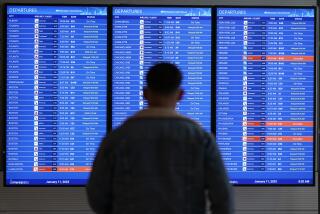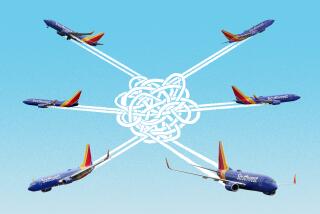Tracking the Airlines
- Share via
Last September the Department of Transportation started tracking the on-time performances of major domestic airlines and publishing the results.
The DOT believes that if consumers know just how bad or good a carrier is at adhering to scheduled arrival times, they could make a better choice when shopping for a seat. In the DOT report a plane landing within 15 minutes of its timetable is considered on time.
The theory was that good timekeepers would get the business and the bad would be encouraged to improve.
In the nine months since the DOT began keeping track, the airlines have been on schedule 76.5% of the time. To many, that is not an acceptable figure.
The percentage, however, is depressed by some of the bad early months immediately after the program began, when some airlines, by their own admission, were doing an awfully sloppy job of following their timetables. Results have been better lately.
In May, the last month for which a DOT report is available, the industry on-time percentage was 81.9%, just a shade below April’s 82.6%. Looking better, some say, but stillot quite good enough.
Industry Leaders
Some carriers are considerably ahead of that level and improving. The May leader, for example, was Southwest Airlines with 92.5%. In April that airline was third with 90.3%.
America West maintained its second-place standing in May with 90.9%, just 0.1% better than its previous month.
American improved two places in May to third with 87.6%, more than 2.5% better than in April. At the same time, Delta maintained fourth place in the listing, while improving its timetable from 85.6% in April to 87.4% in May.
Just looking at the cumulative 10-month average, you might say that Northwest was not doing a good scheduling job. Its record is about 72%, lowest on the list.
That number doesn’t tell the whole story. Northwest has picked up the pace considerably after being one of the poorest timekeepers at the start of the DOT record keeping. For May the Minneapolis-based airline stood in fifth place.
Alaska Airlines’ figures also are deceiving. Its record late last year and early 1988 was poor. It, too, has made tremendous gains in recent months. In April Alaska was 12th on the list with 77.7%. In May it jumped five places, raising its record almost four percentage points.
Here are some of the other May/April percentages: TWA, 81.6% (81.5%); United, 80.5% (81.8%); Continental, 80.1% (81.5%); Piedmont, 77.5% (81%); Eastern, 76.2% (75.5%); USAir, 70.7% (77.9%), and Pan Am, 68.8% (76.5%).
One of the major reasons for the decline in USAir performance from April to May is probably that it is still trying to integrate PSA and another acquisition, Piedmont, into its system.
The industry’s overall improved scheduling is reflected in a drop in the number of passenger complaints received by the DOT. Traditionally, one of the biggest beefs that fliers have is late arrival. Complaints about delays and other flight irregularities dropped from more than 2,000 in June, 1987, to little more than 600 this past June.
Leading in Complaints
Continental and Eastern continue to lead the industry in complaints, ranging from late arrivals to lost and damaged baggage. Continental logged more than 11 complaints per 100,000 passengers flown, and Eastern just more than nine.
Most carriers received between one and five consumer complaints per 100,000. Among the major carriers, Delta was lowest, with just 1.27 complaints.
Two carriers, Alaska and Air Wisconsin, were complaint-free in June, while Southwest received 0.39 complaints for every 100,000 passengers flown.
The airlines are making efforts to tighten up all aspects of their operations. Some flights that failed to stay on schedule month after month have been dropped or brought into line.
Next time you call an airline about a seat, ask the reservations agent for the flight’s on-time performance profile. Your travel agent can call up the same information.
If you don’t think that flights meet their schedules often enough, switch to another carrier. If a sufficient number of people do that, air transportation operators will either have to improve their scheduling or lose market share to competitors.
More to Read
Inside the business of entertainment
The Wide Shot brings you news, analysis and insights on everything from streaming wars to production — and what it all means for the future.
You may occasionally receive promotional content from the Los Angeles Times.










